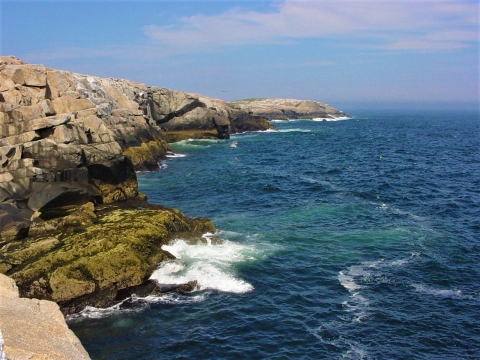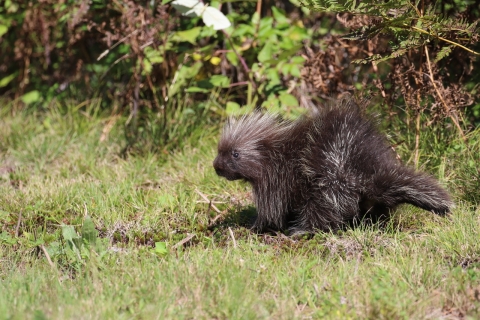About Us
Islands
"Bed and Breakfasts" for the Birds
The refuge's islands are as individual as finger prints. Some support spruce-fir forests. Others are treeless, covered by shrubs and grasses. Still others are mostly bedrock, with little vegetation. Some combine the three. The various habitat types appeal to a variety of bird species.
In addition to seabirds, refuge islands provide habitat for raptors, wading birds, shorebirds, and songbirds. Some of the forested islands, including Outer Heron, Little Marshall, Bois Bubert, and Mink, have active bald eagle nests. Outer White Island supports a black-crowned night heron rookery. Migrating peregrine falcons stop on rocky Seal Island to hunt seabirds and rest. Warblers such as the bay-breasted and blackpoll, and shorebirds, including ruddy turnstones and semi-palmated plovers, rely on the islands as stepping stones on their long trips north and south.
Biological Summary of Islands within Maine Coastal Islands National Wildlife Refuge - pdf
Mainland
The refuge's four mainland properties are located in Hancock and Washington counties. Upland areas are characterized by spruce-fir forests with some mixed hardwoods. The 2,178-acre Petit Manan Point Division, in Steuben, also includes jack pine stands, coastal raised heath peatlands, blueberry barrens, old hayfields, fresh and saltwater marshes, cedar swamps, granite shores, and cobble beaches. The Gouldsboro Bay Division, in Gouldsboro, protects 635 acres, including mature upland forest and a large tidal saltmarsh and mudflat. The 1,150-acre Sawyer's Marsh Division lies at the head of a broad saltmarsh in Milbridge, just north of Petit Manan Point. The recently acquired 431 acre Corea Heath Division, in Gouldsboro, protects a large, raised, coastal peatland and several populations of rare plants
Neotropical migratory songbirds thrive in the forests of the mainland divisions. These birds breed in North America and winter in the Caribbean, Mexico, and Central and South America. Recently, populations of species such as the American redstart, Swainson's thrush, and song sparrow, have declined due to habitat loss throughout their migratory routes.
The saltmarshes and mudflats of the mainland divisions attract waterfowl, wading birds, and shorebirds. Black ducks, great blue herons, and American bitterns ply the waters of the saltmarshes. Semipalmated sandpipers, dowitchers, greater and lesser yellowlegs, and dunlins probe the mudflats for invertebrates.
During fall migration, 80-acre Cranberry Flowage on Petit Manan Point is filled with over 4,000 ducks. Black ducks, green-winged teal, and mallards rest and feed on wild rice in preparation for the long flight south. Long-tailed ducks, surf and white-winged scoters, common goldeneyes, and common eiders winter in coastal waters.
The former pastures and blueberry fields on Petit Manan Point provide nesting habitat for grassland birds such as bobolinks and savannah sparrows. In the spring, American woodcock use the clearings for their unique courtship displays. Whimbrels stop off here during their fall migration from the Arctic tundra to the southern United States. The Service maintains open areas through periodic mowing and controlled burning.
Other Facilities in this Complex
The Maine Coastal Islands National Wildlife Refuge Complex is comprised of five individual refuges which span the coast of Maine and support an incredible diversity of habitats including coastal islands, forested headlands, estuaries and freshwater wetlands. All totaled, the refuge includes approximately 9,478 acres of diverse coastal Maine habitats including forested and non-forested offshore islands, coastal salt marsh salt marsh
Salt marshes are found in tidal areas near the coast, where freshwater mixes with saltwater.
Learn more about salt marsh , open field, and upland mature spruce-fir forest.








